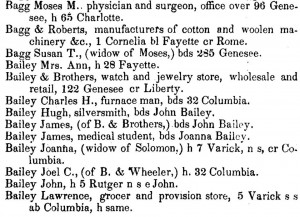To read the original post, click here.
 |
| Bible record for Ebenezer Berry Family, 1835-1936, R. Stanton Avery Special Collections, NEHGS. |
These alternative records can be especially beneficial when an index to the civil vital records is unavailable. Using these alternatives, you can then contact the appropriate authority to provide a copy of the original vital record.
However, what do you do when a vital record simply does not exist? It’s a common problem, especially when documenting older generations, as each state legislated its own vital record compliance. Luckily you can consult several vital record alternatives that can be used to prove birth, marriage, or death. (Most will be accepted as proof by a lineage society.) Here are a few examples:
- Probate records. Probate records, such as wills and administrations, can provide the names of a deceased’s heirs and sometimes the date of death (or an approximation based on the date a will is probated). NEHGS maintains a large collection of New England and Atlantic Canada probate on microfilm. Additionally, several U.S. town and county probate collections are available digitally at FamilySearch.org or on microfilm at the Family History Library.
- Deeds. Sometimes deeds identify specific relationships between the grantor (seller) and the grantee (purchaser). This can be especially helpful in identifying the first name of a grantor’s spouse. Most deed records for the New England states are available on microfilm at NEHGS, while other U.S. land records are available digitally at FamilySearch.org or on microfilm at the Family History Library.
- Military records. From draft cards to pension records, these records often provide very specific information about a soldier’s birth, marriage, and death. In fact, pension records can even include pages that were torn from a family Bible. Some military records are available at fold3.com; Ancestry.com; and FamilySearch.org
- Cemetery records (tombstones or burial records). Be sure to check with a local genealogical/historical society for cemetery transcriptions, as the stone may have been removed or damaged. Also, some national cemetery databases include:findagrave.com; billiongraves.com; and MooseRoots.
- Church records. Baptisms, confirmations, marriages, and funeral records may have been recorded with the church, and not registered on the local or state level. To locate a church record, you must first identify your ancestor’s religion and/or congregation. Some records are still maintained by the original church (or church archives), while others may have been microfilmed or published. NEHGS maintains a large collection of compiled church records from across the United States, and theFamily History Library has some church records on microfilm.
- Bible records. Although rare to find, Bible records can be significantly helpful when available. To locate a Bible record specific to your ancestors, contact the local historical society, archive, or genealogical society associated with the family. NEHGS maintains a large collection of bible records in the Stanton Avery Special Collections.
- Published genealogies and local histories. Often unacceptable as proof for a lineage society, these published resources can at least provide an approximation of birth, marriage, and death. NEHGS has a collection of 30,000 published genealogies and 40,000 local histories. Also, several sites have digitized material, including theNEHGS Digital Library and Archive; Internet Archive; Google Books; and Family History Books.
- City directories. Like census records, city directories can be used to approximate a person’s date of death, as the person may disappear from the record altogether, or their spouse may be listed as a widow. Sometimes, if you’re lucky, the directory will identify a specific date of death. NEHGS maintains a large collection of city directories, as well as ancestry.com.

No comments:
Post a Comment